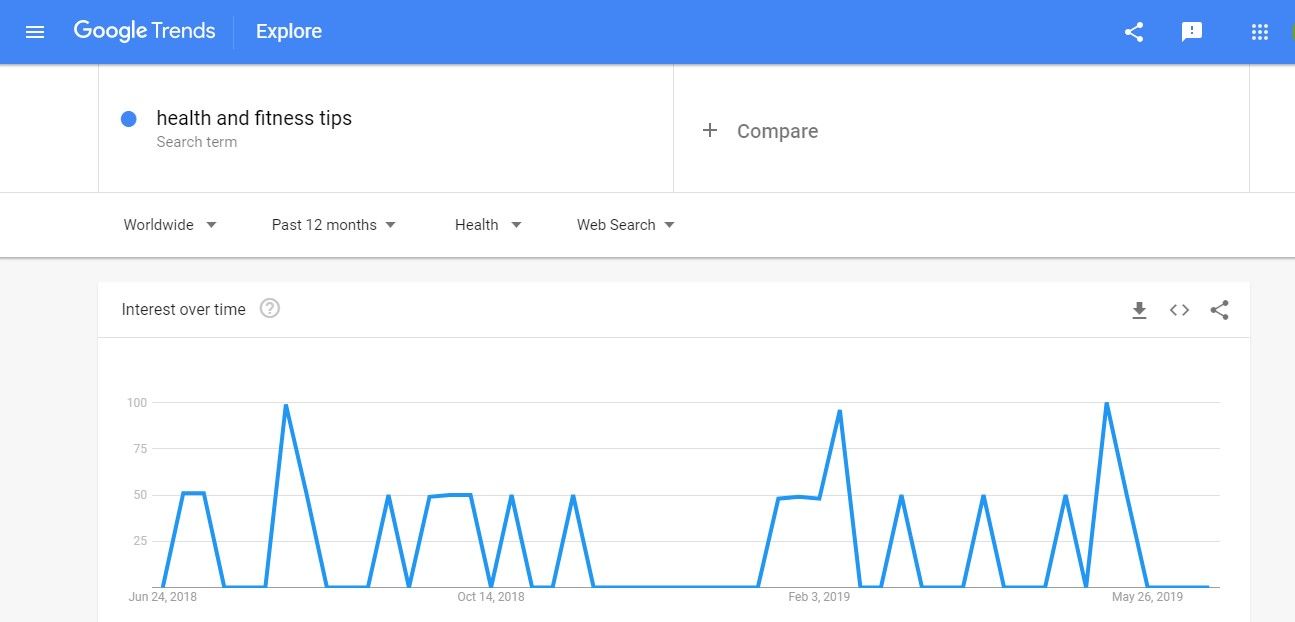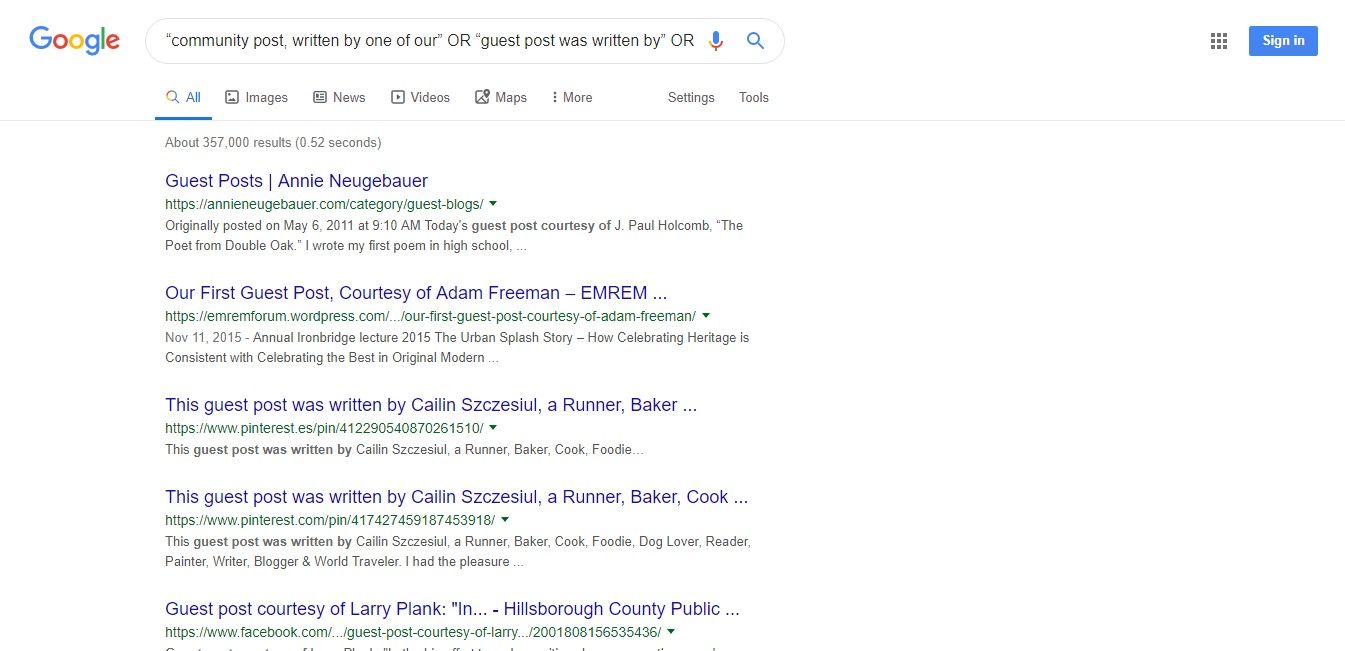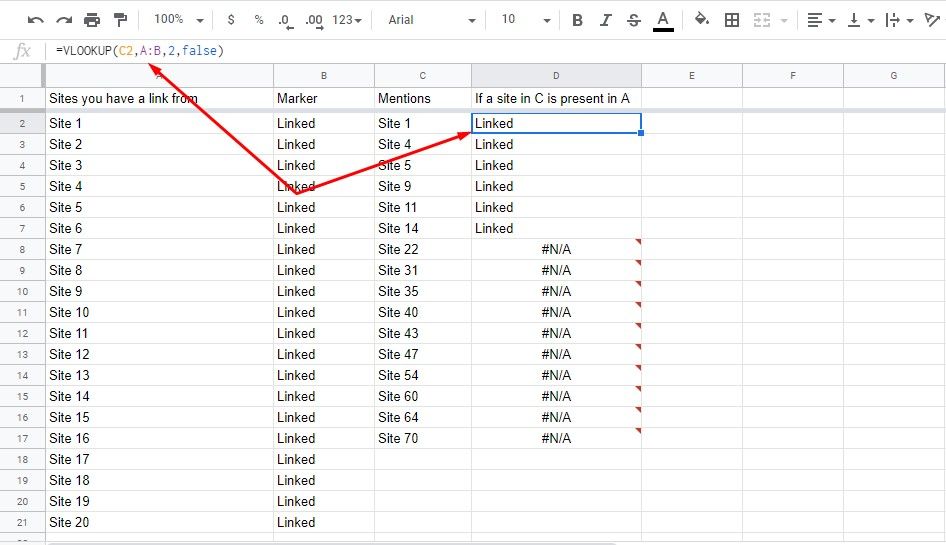Step 1: do a thorough client research
As we already mentioned, health and fitness is a rather difficult niche to take over so easily. In order
to start off on the right track, you should first get to know your client and figure out what they can
offer that others cannot. This involves:
- Learning your client’s unique tone of voice
- Conducting a research on their current content and linkable assets
- Learning what their overarching goals, standards and values are
This very first step has a potential to supply you with enough data that will act as building blocks for
your off-site SEO strategy (more on this aspect of research later in this post).
To make sure this step goes well, your client analysis must include:
-
Determining their goals - schedule a meeting during which you will talk about what your client’s
goals are. This is critical when it comes to coming up with potent and carefully tailored off-site SEO
tactics, especially in terms of keyword research and the competitors they find admirable.
-
Detailed content audit - go through their content pieces and determine which posts need to be
improved, deleted, updated, expanded (or shortened), repurposed, etc.
-
Your client’s investing capabilities - make sure you are on the same page regarding what assets
they are willing to deploy. In other words, determine how much time, effort and money they are truly
willing to invest, so you can come up with a tailored, effective yet realistic link building strategy in
accordance with their overall goals.
Important Note: This is where you need to establish yourself as an active marketing advisor who
will take the wheel from here on out. So, if they have certain wishes that are unrealistic or simply
plain wrong, you need to bring this issue up right away. For example, if your client insists on not
including forums in their link building efforts, while you know there are numerous opportunities
available through health and fitness forums, make sure you educate them properly and explain why they
need to revisit their approach.
-
Additional SEO assets - inquire about your client’s link building opportunities aside from their
website and content. Maybe they have relevant industry connections and partners through which you can
reach wider audiences.
Step 2: competitor research
Track down your client’s most successful competitors and
examine their link building strategies
so you can get valuable insights about which SEO practices work best within the fitness and health niche.
What you need to examine:
Competitor’s strongest content pieces
Take into account the
content that generates most attention
according to the following metrics: on-page time, organic traffic, shares, links, likes, etc.
ADVANCED TIP:
While examining their content, be sure to take into account any interesting fitness and health topics
that haven’t been covered by the competitors. These can come in handy later on when you start creating
content for your customer.
Once you feel like you have a firm grasp on which aspects of their posts are directly influencing
their success, try to replicate them for your client, but make sure your client’s content has a
personal touch.
Keywords and anchors
While going through their content, pay close attention to competitors’ keywords deployment and the use
of anchors. There will likely be numerous great keyword ideas right off the bat and you will have a nice
overview on which keywords should be in focus and which ones are to be disregarded altogether. As for
the anchors, take into account both incoming and internal link anchors.
ADVANCED TIP:
Names of prominent influencers, brands and industry events from the health and fitness niche can really
make a difference when it comes to your keyword research, so be sure to take those into account as well.
Backlinks
Exploring the competitor’s backlinks brings you much more than just the opportunity to emulate them by
contacting the same sites they did. Of course, first you need to know what you are looking for.
During the segments to follow, we will keep reminding you what to look out for during competitor analysis,
for now, suffice it to say that you should keep track of all the major influencers and their contact info;
that you should keep an eye out for broken links that used to lead to resources that you have something
similar to, or could try to reproduce; and that you should be noting down common footprints found on
websites that you find interesting, as they will be of immense help once you actually start prospecting
for new linking opportunities.
Step 3: target audience research
If you want health and fitness bloggers to accept your guest post submission, or a reputable site to add
your post to their ‘Resources’ page; you have to understand their audience. After all, they are your
client’s desired audience as well.
You can find out a lot about their habits and preferences simply by:
- Reading their comments on blog posts or forums
- Joining relevant groups and communities on social networks
- Observing their behavior in Google Analytics
- Using Google Trends, or a similar tool, to find out what is currently popular
If you invest enough time and effort into this part of research, you’ll learn which tone of voice to use
when writing for this audience; what kind of posts do they like to read and share; which social networks are
they are easiest to reach through, how they usually formulate their queries in search, and much, much more.
Once you have all that you need, it’s time to move on to the next stage in the process.
Link building tactics for health and fitness websites
Examining sites and backlinks of your competitors is not only supposed to lead you directly to all kinds
of prospects, but it also gives you all the information you need to look for similar websites with
Dibz or Google.
We decided to cover some of the most popular link building tactics for health and fitness websites. If you
want a more exhaustive list of these tactics, or an explanation for some of the terminology we’ll use, you
can take a look at our
Link Building 101
post, which should answer most if not all of your questions.
Guest posting on health and fitness blogs
Due to its unique ability to expose you to relevant audiences through contextual links with anchors you
get to decide, and all of that without you having to pay for those links; guest posting recommends itself
as one of the most effective link building tactics in most niches, not just in health and fitness. You can
find adequate blogs to outreach
with your guest post proposition in a number of ways:
- You had to have come across quite a few during competitor research
- Comment sections of relevant blogs are a great place to look for other health and fitness bloggers
-
Prolific authors will often share their posts, and thematically similar ones on their social network
profiles
-
A reverse image search with headshots of those authors, or with common stock photos will also lead you to
interesting blogs
However, since Dibz gives you a streamlined way to perform a number of live searches simultaneously,
allowing you to find an impressive number of prospects in a matter of minutes, here are the three basic ways
to
find health and fitness guest posting opportunities with Dibz. Of course, the same queries would work in Google as well.
1) Looking for ‘Write for us’ pages.
One of the most common methods for looking for blogs that accept guest posts - it might not always lead to
the highest-quality websites, but at least they should be willing to hear you out. In Dibz, we use
advanced parameters (common footprints, modified by advanced operators or not) to define what page you are
looking for, while you need to provide the keywords that will make it clear what niche you are interested
in.
Parameters
-
intitle:"Submit an Article" OR intitle:"Guest Post Guidelines" OR intitle:"Contribute to our site"
- intext:"Your article will be published" OR intext:"Your post must be original"
-
inurl:/submit-article/ OR inurl:/contribute/ OR inurl:/guest-blogging-guidelines OR inurl:/write-for-us/
Keywords
- nutrition during pregnancy
- healthy eating
- healthy diet
- important nutrients
- refined carbs
- omega-3 fatty acids
- "big five" of nutrients
- benefits of exercise
- stay healthy
- workout routine
- fitness coach
- strength training
- cardio workout
- anaerobic exercise
- dumbbells
- barbells
- fitness regime
- working out
- fitness goals
- targeting specific muscle groups
- easy weight loss
- healthy lifestyle
- stubborn pounds
- sports injuries
- balanced diet
- gym equipment
- athletic clothing
- over-train
2) Looking for published guest posts.
There are plenty of websites out there which are perfectly open to publishing guest posts, but that don’t
have a ‘write for us’ page. The best way to find them is to look for the guest posts they’ve already
published.
All you need to do is to combine some of the following parameters either with the keywords that are likely
to show up on ‘write for us’ pages, that we’ve provided above, or with names of popular niche authors,
exercises, pieces of equipment or brands likely to be mentioned in (guest) posts on health and fitness
websites.
Parameters
- guest AND post OR article OR contribution OR journal
-
"community post, written by one of our" OR "guest post was written by" OR "guest post courtesy of"
- "guest contributor" OR "guest blogger" OR "contributing writer"
3) Looking for health and fitness blogs in general
Even though this kind of search is likely to have the lowest response rates of the three methods described
here, it is also likely to produce the highest percentage of above-average links in terms of quality.
Just because a blog doesn’t have obvious markers of being open to guest posting, that doesn’t mean they
aren’t, or that you won’t be the first who manages to persuade them to change their mind.
Keywords we described so far are applicable in this method as well, and as for parameters, you can improvise
with everything indicating that what you are looking for is a blog. Some suggestions are below, but if you
scan the blogs you like for other common footprints, you are bound to come across dozens.
Parameters
- inurl:/2019/ AND inurl:/blog/
- intext:"this blog is meant" OR intext:"we write about" AND inurl:about
- inurl:category/health OR inurl:category/fitness intext:blog OR intitle:blog
Brand mentions
If you are promoting a personal blog or something of the sort, this tactic may not be available to you,
but if your client is a brand name in the health and fitness industry, whether a chain of gyms, or
equipment and supplements manufacturer, this might be a gold mine of opportunities.
All you have to do is search the web for mentions of your brand name, check which of them are not linking
to your site, discard the ones that you don’t want a link from, and start outreaching those that remain.
Naturally, if the site you are promoting can boast popular thought-leaders and influencers in its
editorial staff, you can instead look for mentions of their name and ask for them to be accompanied with a
link to your site.
There are plenty of ways to do this, from actively monitoring your brand mentions with Google Alerts and
checking them for links manually, to using Dibz or Google to find all the pages talking about you, and
cross reference them with your backlink portfolio to identify the ones that aren’t linking to you.
ADVANCED TIP:
One of the fastest ways to compare two large lists is by the use of VLOOKUP command in Google Sheets or
Microsoft Excel, by identifying those from one range that are also appearing in the other.
Giveaways and reviews
While this tactic might often be more in the area of gray-hat than
white-hat SEO, like
with most of the other methods, how spammy it is going to be depends mostly on the execution. If you are
hoping to use your products or vouchers for your services as a bribe to get someone to write a mindless
praise of your brand - you’re approaching it wrong.
What you should be looking for is exposure to qualified audiences and an honest review from a credible,
trusted source. While it would be great to only have nice things written about you, audiences are more than
capable of telling when a reviewer is being genuine. The ones that aren’t might be more convenient, but a
link from their site is not likely to carry any kind of weight. Again, competitor research should bring a
decent amount of sites open to this kind of arrangement, make a list of common footprints you’ve found
there, and use them for this kind of research. When combined with product or service you’re offering, your
queries might look something like this:
- nutrition supplements inurl:product-review
- gym equipment intitle:product AND intitle:review
- omega-3 inurl:giveaway
ADVANCED TIP:
Sometimes queries like the last one won’t lead you directly to prospects, i.e. websites willing to accept
giveaways, but instead to those offering them. When this happens simply run those sites through a backlink
checker, and you’ll get a list of actual prospects you can contact.
Resources and links pages
Even the health and fitness websites that are not discussing the most complex aspects of these industries
are never far from actual, serious science. If you want to have any kind of credibility in this niche, you
have to make sure that your content is as meticulously researched as the seriousness of the subject matter
demands.
This means that there is no shortage of websites recommending resources they have found to be valuable and
reliable.
While
this tactic requires
a much less significant investment when you already have a resource you think might be found worthy of
inclusion in the lists of this kind, things aren’t so grim even when you are starting from scratch.
While you will need to spend some time and money on creating a really impressive piece of content, the fact
that you will have already been through competitor research and have spent some time looking for prospects
of this type, will mean that you have a very solid idea of what kind of resources usually get linked to, and
thereby, what kind of a resource you should be creating.
We’ll provide some handy advanced parameters below, and as for keywords, you should use the names of
respectable health and fitness authors; phrases describing the resource you intend to offer; common elements
of research titles in your niche, etc.
Parameters
- intext:"suggest a link" OR intext:"suggest a resource" OR intext:"suggest a study"
- inurl:resources OR inurl:"favourite resources" OR inurl:links OR inurl:"favourite links"
- intitle:"other resources" OR intitle::"favorite resources" OR intitle:"favorite tools"
- intitle:resources OR intitle:links OR intitle:"further reading" OR intitle:"more resources"
Outreach
We’ve already mentioned how even the more casual posts in this niche might deal with serious science,
which means not a lot of people will be thrilled to stake their reputation on something you’ve written
unless you have an impressive range of references or even actual credentials. This makes
outreach for health and fitness link building
a rather demanding activity, one that you need to really be proficient in if you want to hope for any kind
of success.
That’s why we decided to go straight to our link builders, and ask them for tips on best ways to do guest
posting outreach for health and fitness sites. We chose this particular tactic not just because it is the
most popular one, but also because it perfectly illustrates what your outreach should look like for other
link building methods as well. Here’s what our link builders with most experience in these niches had to say
about:
The subject line
While it is generally a good idea to keep this short, adding the name of the person you are contacting or
the name of their blog has been
known to improve open and response rates. You should make it obvious that you are writing with the intent of contributing to the site, but some
bloggers are immediately repelled by the sight of the phrase "guest post" in their inbox, so you might
want to avoid that particular term.
On the other hand, bloggers who are generally open to this kind of collaboration (for instance, those whose
blogs you’ve found by looking for ‘write for us’ pages) will often appreciate you giving them an idea of
what you would be writing about in the subject line, but this can sometimes backfire by making them realize
they are not interested before they even open your email.
Finally, some link builders have noticed their response rates have improved after they started phrasing
their subject lines as questions, as this seems to further incentivize the bloggers to at least open the
email.
Email content
The email itself should also be on the short side. As most people in health and fitness niches you
outreach will have a fairly good idea of why you are contacting them, you shouldn’t spend too long dancing
around the fact. Apart from testing their patience, if you appear like you are trying to hide your true
intention, you might even come across as insulting or deceptive. Simply list how you found them, what do
you like most about their site, and move on to explaining why you think you are qualified to write a guest
post for them.
This where your references are of crucial significance, the more high-profile publications that you can
prove you already published guest posts on, the likelier that your pitch will be accepted. If there are too
many of them for you to comfortably list them in the email itself, you can always create a free online
portfolio page on one of the platforms offering that service, and send the link to that page instead.
Your email should be impeccably formatted and tidy, suggesting that you’ll have the same kind of attention
to detail when composing the post you are offering. Aside from showing that you know quite a bit about the
blog you are contacting, the email should also convey your general knowledge in the subject matter.
Researching the trending topics in the micro-niche of the site you are contacting is a great way to show
that you are staying current and that the content you’ll provide is likely to be high-quality.
Personalization
We’ve touched upon this in the previous outreach sections, but there’s more to email personalization than
simply using the blogger’s name in the subject line.
For one, there is the register and tone of voice you’ll use. While some personal bloggers will prefer to
stay informal, those dealing with more complex subject matter or with serious health related issues should
always be approached in a professional, straightforward manner.
But this is not the only thing that you need to know about a blogger before contacting them. For instance,
you also need to know how involved they are in the blog they are running. If they are not too concerned
about staying ahead of the curve and offering in-depth topics, your submission should also be based around a
generic trending topic, as those are the ones they are likely to accept. However, if you notice that they
are putting a lot of work into filling their editorial calendar, your pitch better be equally specific and
well-formulated.
Finally, even though these are exact sciences we are talking about, it’s amazing how wildly opinions on
certain subjects can differ. While one respected blogger will praise the keto diet as the best idea ever,
another one will have nothing but derision for it. If you are hoping to elicit a positive response, you
shouldn’t even start an outreach email before taking the time to get to know a little bit about the
blogger’s views on the subject you intend to propose.
Email template for health and fitness guest blogging outreach
Hi,
[Name] here, I’m a regular contributor at [a blog you frequently post on]. Our content is focused on
fitness, health and everything in between.
I’ve thoroughly enjoyed reading your posts! I wanted to contact you and see if you’d perhaps be interested
in collaborating with me on creating some content for your site. I have over X years of experience working
in the fitness industry and I’d love to be able to contribute to [their blog].
Here are some of the topics I am currently working on:
- [Topic 1]
- [Topic 2]
- [Topic 3]
Let me know if you might be interested in publishing one of them and I will send the final draft to you. If
you’d like to see more of my previous work, you can find some of the posts I’ve written for other
publications linked below, or take a look at my online portfolio page[linked]:
- [Linked post title + site name 1]
- [Linked post title + site name 2]
- [Linked post title + site name 3]
Also, please let me know if you have any ideas for new and engaging posts - I would be happy to provide
content for you!
Thank you for your time, and I look forward to hearing from you!
All the best, [name]
The bottom line
While there is no way to cover all the potentially effective link building methods for sites in health and
fitness niches, we did our best to show you what the entire process of creating and executing this kind of
digital marketing strategy would entail.
Hopefully, you’ll test some of the queries we’ve provided you in Google, and once you are confident you know
how they work, use them to get impressive amounts of prospects with Dibz in a fraction of time you’d have to
spend looking for them in the SERPs.
If there are some parts of the process that you are still not clear on, or if you would like to learn more
about other link building rules and tactics, our Learn SEO section already has quite a few useful resources,
and is only going to keep growing, so give it a visit!

 We fixed link building
We fixed link building We fixed link building
We fixed link building We fixed link building
We fixed link building We fixed link building
We fixed link building Use cases
Use cases Outreach
Outreach Buying links
Buying links Selling links
Selling links Features
Features Backlinks Health Check
Backlinks Health Check Link Building API
Link Building API Blacklisted Links
Blacklisted Links Easily Sell Links
Easily Sell Links SEO Metrics by Ahrefs
SEO Metrics by Ahrefs Chrome extension
Chrome extension Link Building Database
Link Building Database Team Management Tool
Team Management Tool SEO Reporting Dashboard
SEO Reporting Dashboard Index Your Backlinks
Index Your Backlinks LB Outreach Management
LB Outreach Management Expiring Links Alerts
Expiring Links Alerts Automatic SPAM Analysis
Automatic SPAM Analysis Link Building Transparency
Link Building Transparency Google Link Index Checker
Google Link Index Checker Manage External Link Builders
Manage External Link Builders


